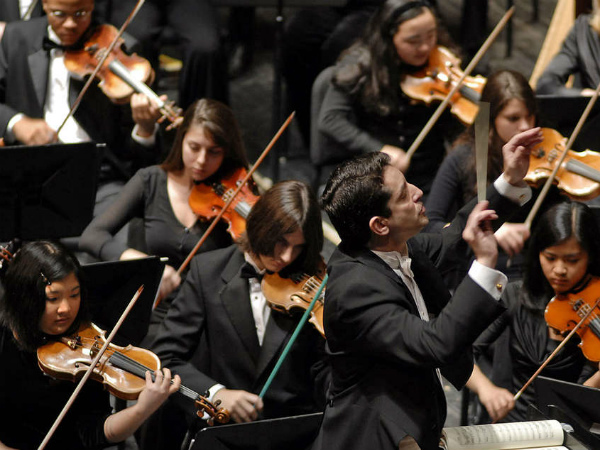One of the most important and powerful benefits of music is its capacity to build communities, both large and small, that can last a lifetime. I was recently reminded of that capacity by a television commercial. The opening scene shows four middle-aged men, instrument cases in hand, greeting each other. After a cutaway to a black-and-white photo of what is obviously the same four men playing music together as young adults, the final scene shows them playing together again, forty years later.
Music’s potential to build community, not only through attendance at a music event, but, more important, by providing opportunities for actual participation, is something that cannot be undervalued or overestimated. Music’s powerful influence in this regard is largely due to the fact that you can participate in music for your entire life. That is why it is so important that we offer broad access to music education in our schools from an early age throughout high school.
The most common way to reap the benefits of music’s community building potential is through continued participation in bands or jam sessions. There are all types of bands with all kinds of sponsoring agencies. Whether a community band, a group of friends forming a rock or jazz band, or simply a loosely coordinated, regular drum circle, there are plenty of opportunities to become an active, participatory member of a music community, regardless of your age or ability. In fact, it is widely accepted that being connected to others and part of a community becomes more important as we age.
And it is not simply small bands or groups of friends that can define a “music inspired community. There can be all types and sizes of music communities.
I have had the great fortune to witness music’s continuing capacity to build community through my work with Music For Everyone. One of MFE’s key mission components is to cultivate the power of music as a community-building tool. Two of MFE’s programs provide great examples of music’s ongoing community-building potential.
The MFE Community Chorus is a choral group that gets together one night a week to sing. The group is open to anyone, regardless of age or ability. Average attendance at the weekly gatherings is between fifty and seventy, with over a hundred members in total. The chorus is a vibrant community in and of itself. It brings together a very diverse group of people who have bonded in ways that go beyond music. Friendships have blossomed. Members emphasize how much they enjoy the group and how much it means to be a part of it. And the group has developed its skill to the point where it has public gigs that draw crowds in the hundreds.
MFE’s Keys for the City program, in which between ten and twenty artistically designed and painted pianos are placed throughout the city of Lancaster each summer, is another powerful example of music’s ongoing ability to build community. Whether you are a virtuoso or a beginner, whether you play Chopin or “chopsticks,” you have access to these pianos. Everyone who has played one of these pianos or heard one being played while walking through downtown Lancaster is connected. Literally tens of thousands of magical musical moments occur around those pianos each summer with people of all ages, races, and beliefs coming together to share the community building power of music. They all share this common civic and very public experience.
A major part of that shared public experience is the extraordinary way the citizens of Lancaster have embraced the program and care for these pianos. The first season, there were serious doubts the pianos would last a week on the streets before being vandalized and destroyed. But Lancastrians proved the naysayers wrong. That first year, after 20 pianos were on the streets available 24/7 for four months, there was one incident of vandalism. This very public display of caring and responsibility has resonated throughout the community. It has instilled a sense of civic pride in the decency and integrity of the citizens of the Lancaster community. Keys for the City has had a profound impact on Lancaster’s vibrant arts scene by providing a random gift of music, uncountable times throughout the city all summer long. This is a real-life testament to music’s tremendous ability to contribute to a sense of community in profound and ongoing ways.
Further, because music is the universal language, its potential community-building impact is not only local but global. There are all types of musical groups that bring together young adults for tours of foreign countries, which enables them to learn about and appreciate different cultures as a way of demonstrating that we are all part of a world community. In an age that demands the crossing of cultural and national divides, a universal language has great value.
Meanwhile, the number of ways in which music can be utilized to build community through such venues as concerts, benefit shows, tours, street events and exhibits, is essentially limitless.
But what do these and other community music programs have to do with educational funding priorities of our high schools?
A primary purpose of our educational system is to encourage and inspire a commitment to and love of life long learning. But that is simply the beginning. We must also provide students with the experiences on which to base this commitment, as well as the resources necessary to build a foundation to be an active life-long learner. Education continues after your school years are over. An investment in quality, broad-based and accessible music opportunities and programs can foster an interest in, and life-long love of, music and, as a result, a lifelong continuation of the benefits and lessons learned through such participation.


